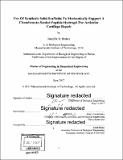| dc.contributor.advisor | Alan J. Grodzinsky. | en_US |
| dc.contributor.author | Ibañez, Jennifer R | en_US |
| dc.contributor.other | Massachusetts Institute of Technology. Department of Biological Engineering. | en_US |
| dc.date.accessioned | 2017-12-05T19:15:12Z | |
| dc.date.available | 2017-12-05T19:15:12Z | |
| dc.date.copyright | 2017 | en_US |
| dc.date.issued | 2017 | en_US |
| dc.identifier.uri | http://hdl.handle.net/1721.1/112491 | |
| dc.description | Thesis: M. Eng., Massachusetts Institute of Technology, Department of Biological Engineering, 2017. | en_US |
| dc.description | Cataloged from PDF version of thesis. | en_US |
| dc.description | Includes bibliographical references (pages. 49-52). | en_US |
| dc.description.abstract | Post-traumatic osteoarthritis (PTOA) is a subtype of OA associated with cartilage defects caused by traumatic joint injury. Because articular cartilage has a limited innate healing response, due to its avascular, aneural, and alymphatic nature, these defects lead to chronic degenerative joint disease if left untreated. Current treatments to repair articular cartilage generally result in fibrocartilage that is mechanically and biochemically inferior to native hyaline tissue. This has motivated the development of tissue engineering strategies for cartilage defect repair. Hydrogel approaches have shown promising results in their ability to induce chondrogenesis, proliferation, and cartilage-like matrix production, but are often very soft at early time points and at risk of damage from joint articulation. Solid scaffolds solve this mechanical problem, but often sacrifice bioactivity and integration with native tissue. In order to avoid the drawbacks of each of these approaches, we proposed a composite scaffold approach using a synthetic solid scaffold, made of bioabsorbable polyglycolic acid:trimethylene carbonate (PGA:TMC) or expanded polytetrafluoroethylene (ePTFE), loaded with a chondrocyte-seeded self-assembling peptide hydrogel, [KLDL]₃. We hypothesized that these composite scaffolds would benefit from the mechanical protection of the solid scaffolds as well as the pro-chondrogenic and proliferative effects of the KLD hydrogel, allowing chondrocytes to produce cartilage-like extracellular matrix in a protected mechanical environment. To test the potential of these composite scaffolds for use in cartilage repair, we measured cell distribution, viability, matrix production and accumulation, and static and dynamic mechanical properties. We found that cells could be evenly distributed through at least one of the solid scaffolds tested, with all showing proliferation and maintenance of viability over four-week culture. Per-cell matrix production was an order of magnitude higher than in KLD hydrogels alone. Mechanical properties of composite scaffolds appeared to be dominated by the solid scaffolds, showing that they offered mechanical protection to the soft hydrogel within. Use in a cartilage defect model showed potential for integration with native tissue given optimization of gel-casting methods. Overall, our results show that these composite scaffolds are a viable tissue engineering strategy for articular cartilage repair. | en_US |
| dc.description.sponsorship | "Funded by the National Science Foundation and W.L.Gore & Associates, Inc."--Page 3. | en_US |
| dc.description.statementofresponsibility | by Jennifer R. Ibañez. | en_US |
| dc.format.extent | 52 pages | en_US |
| dc.language.iso | eng | en_US |
| dc.publisher | Massachusetts Institute of Technology | en_US |
| dc.rights | MIT theses may be protected by copyright. Please reuse MIT thesis content according to the MIT Libraries Permissions Policy, which is available through the URL provided. | en_US |
| dc.rights.uri | http://dspace.mit.edu/handle/1721.1/7582 | en_US |
| dc.subject | Biological Engineering. | en_US |
| dc.title | Use Of synthetic solid scaffolds to mechanically support a chondrocyte-seeded peptide hydrogel for articular cartilage repair | en_US |
| dc.type | Thesis | en_US |
| dc.description.degree | M. Eng. | en_US |
| dc.contributor.department | Massachusetts Institute of Technology. Department of Biological Engineering | |
| dc.identifier.oclc | 1011508946 | en_US |
